Transition Smuggler
Wheel Size: 29’’
Travel: 130 mm rear / 140 mm front
Geometry highlights:
- Sizes offered: S, M, L, XL, XXL
- Headtube angle: 65°
- Seat tube angle: 78.1° (size Large)
- Reach: 485 mm (size Large)
- Chainstay length: 435 to 443 mm (varies by size and frame material)
Frame material: Aluminum and Carbon Fiber versions available
Price:
- Frame w/ Fox Float X Factory shock: $3,700
- Complete bikes: $4,000 to $8,500
Test Location: Western Washington
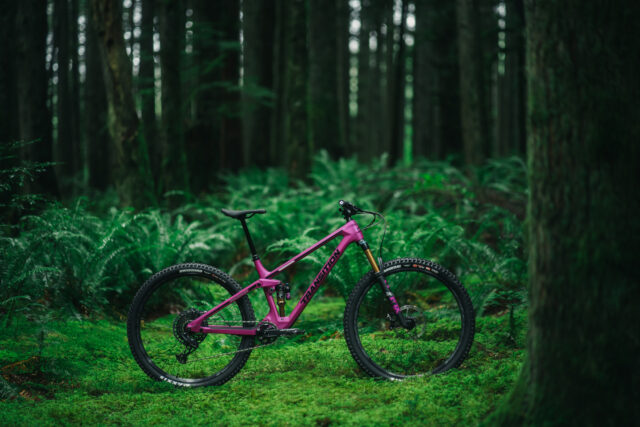
Intro
The Transition Smuggler was a longstanding and super-popular model in Transition’s lineup, as one of the early super-aggressive short-travel Trail bikes on the market. And then it disappeared. The Spur kind of sort of filled that niche, but is a good bit more XC-oriented than the Smuggler had been, and so there was a notable gap in Transition’s lineup between the Spur and Sentinel, which hadn’t been filled for a while. Until now.
The Frame
The main details of the Smuggler frame aren’t going to surprise anyone who’s been paying attention to Transition’s bikes in recent years — it’s a Horst link bike with a short rocker in front of the seat tube and a vertically oriented shock. Transition doesn’t publish full kinematic data for the Smuggler, but says that the linkage has about 27% total progression — which is to say, a fair bit, but nothing far out of the norm. The Smuggler also features a SRAM Universal Derailleur Hanger, room for a full size water bottle inside the front triangle across the size range, an accessory mount underneath the top tube, molded rubber guards on the chainstay, seatstay, and downtube, and so on.
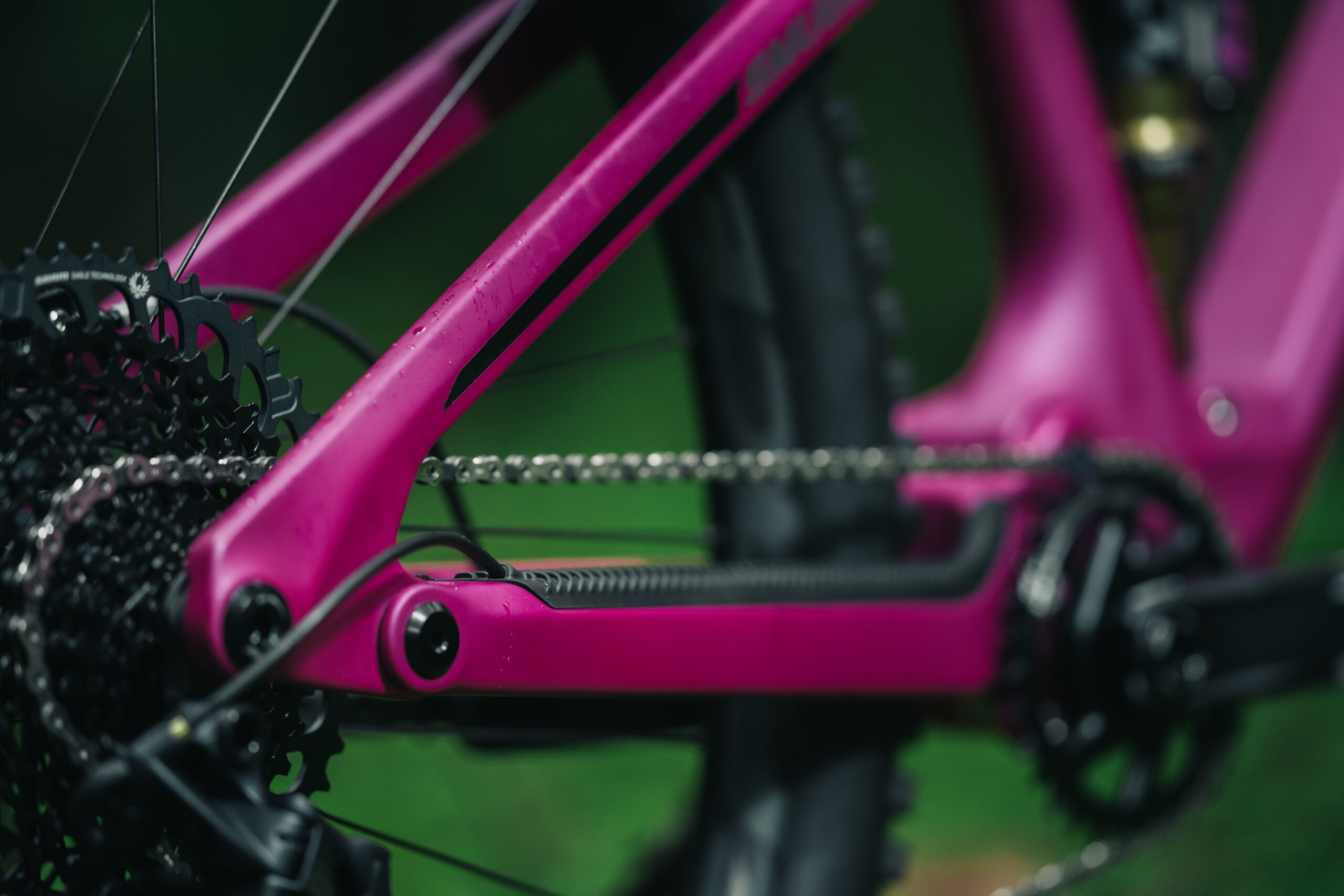
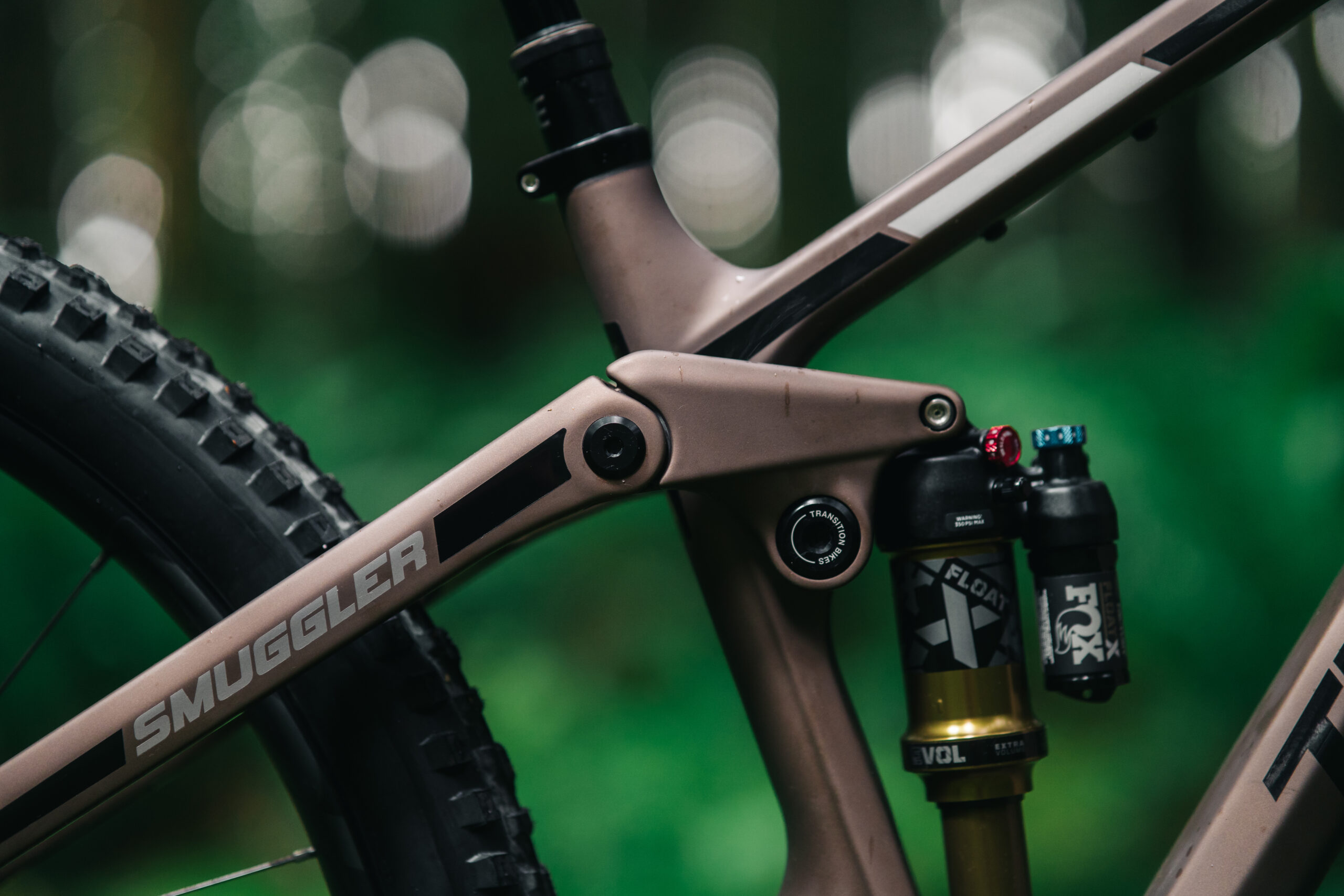
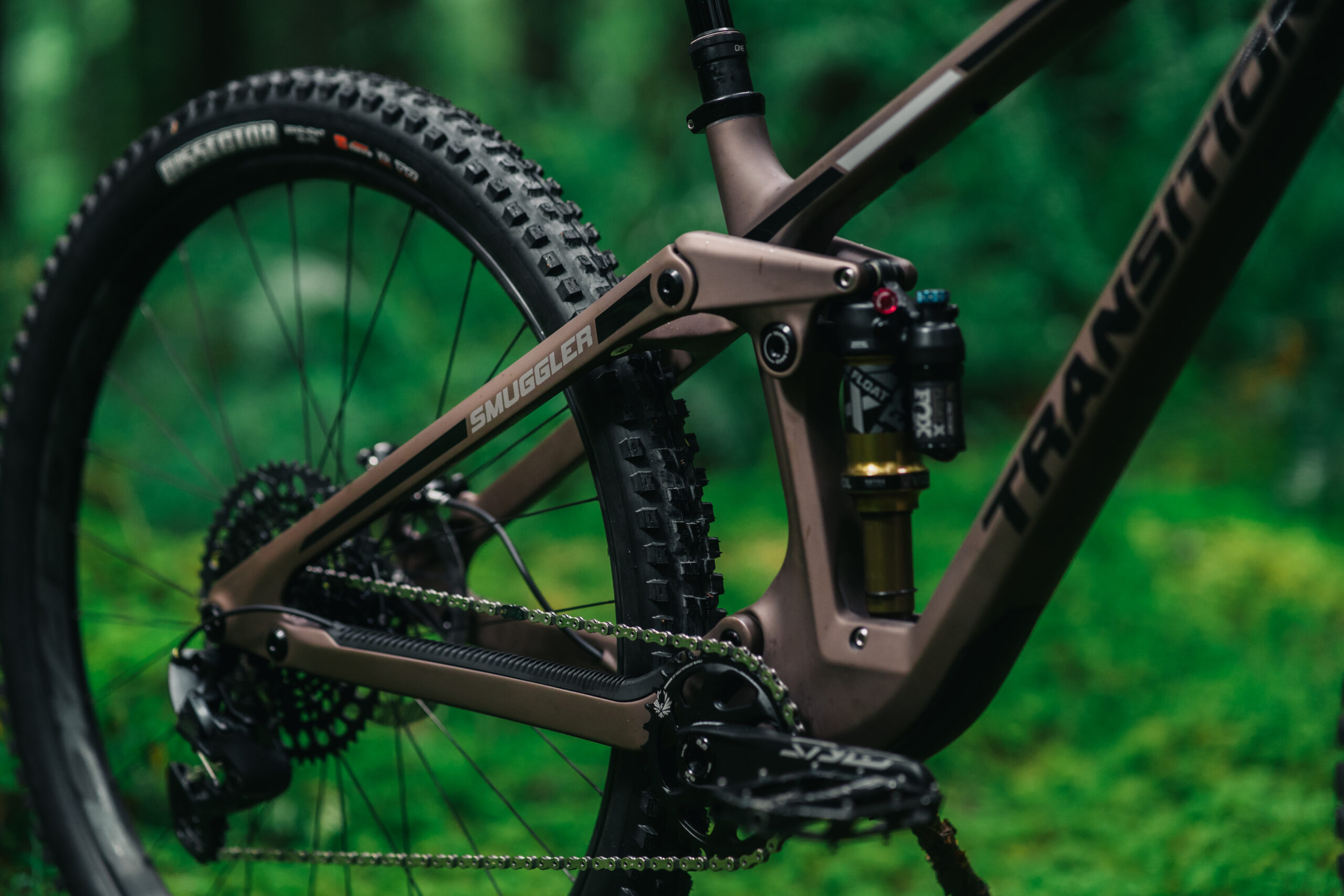
But there are a few details that are new. For one thing, the rear shock uses a standard mount (210 x 50 mm stock, or compatible with a 210 x 55 mm one to produce 140 mm travel), whereas most of Transition’s current models (the Spur excepted) use a trunnion mount shock. Transition has also moved to an IS headset, with the bearings dropped directly into the frame in lieu of pressed-in cups. Transition says that allows them to put the cable routing ports at the front of the headtube for cleaner routing, and all three get full-length internal tubes to make routing straightforward. The frame weight is stated at 6.6 lb (3.0 kg) for a Medium carbon frame, with shock.
The Smuggler also forgoes the geometry-adjusting flip chip that Transition has on their longer-travel models, so what you see is what you get there. But as per usual for Transition, that geometry is definitely on the aggressive side of things for this travel range. So on that note:
Fit & Geometry
Transition offers the Smuggler in five sizes, labeled Small through XXL, and in keeping with those nominal sizes, it runs pretty big. All five get a 65° headtube angle and seat tube angles in the 78° range (varies a little by size). Reach starts at 430 mm for the Small and grows to 460 mm on the Medium, followed by 25 mm steps between each of the subsequent sizes. The chainstay lengths are semi-size specific, starting at 435 mm on the Small and Medium, with the size Large and up bumping up to 440 mm — for the carbon frames. Interestingly, the aluminum versions bump that up to 437 and 443 mm. Bottom bracket drop is 35 mm across the board.
The Builds
Transition is currently offering the Smuggler as a carbon fiber frame with a Fox Float X Factory rear shock for $3,700 or in one of four complete builds as described in more detail below. Frames are available now, with complete bikes shipping in the spring.
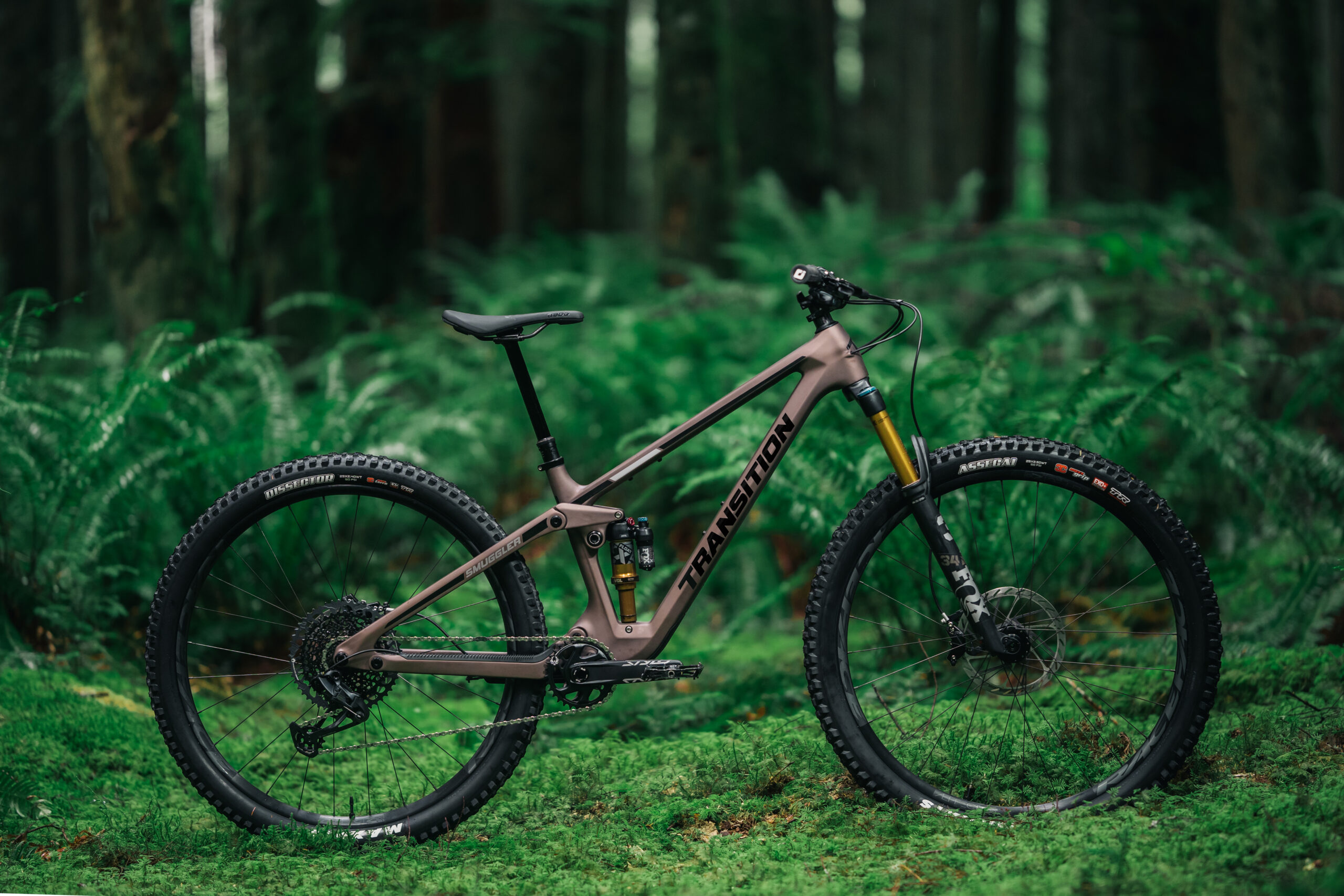
- Drivetrain: SRAM NX
- Brakes: SRAM Code R (200 mm front / 180 mm rotors)
- Fork: Marzocchi Z2
- Shock: Fox Float X Performance
- Wheels: WTB ST i30 w/ Novatech hubs
- Dropper Post: OneUp (S: 150 mm; M: 180 mm; L–XXL: 210 mm)
- Drivetrain: SRAM GX
- Brakes: SRAM Code R (200 mm front / 180 mm rotors)
- Fork: Fox 34 Performance
- Shock: Fox Float X Performance
- Wheels: WTB ST i30 w/ Novatech hubs
- Dropper Post: OneUp (S: 150 mm; M: 180 mm; L–XXL: 210 mm)
- Drivetrain: SRAM GX AXS
- Brakes: SRAM Code RSC (200 mm front / 180 mm rotors)
- Fork: Fox 34 Performance Elite
- Shock: Fox Float X Performance Elite
- Wheels: RaceFace Aeffect R rims w/ RaceFace Trace hubs
- Dropper Post: OneUp (S: 150 mm; M: 180 mm; L–XXL: 210 mm)
- Drivetrain: SRAM X0 T-Type
- Brakes: SRAM Code Ultimate Stealth (200 mm front / 180 mm rotors)
- Fork: Fox 34 Factory Grip2
- Shock: Fox Float X Factory
- Wheels: Crank Brothers Synthesis Enduro Alloy rims w/ Industry Nine 1/1 hubs
- Dropper Post: OneUp (S: 150 mm; M: 180 mm; L–XXL: 210 mm)
All the builds come with Maxxis Exo+ MaxxTerra Assegai front / Dissector rear tires, in keeping with the Smuggler’s intentions as a relatively aggressive bike.
Some Questions / Things We’re Curious About
(1) There’s a big spectrum in ~130 mm travel Trail bikes these days, with ones that feel quite snappy and XC-derived, and others feeling much more game-on and descending-focused. The Smuggler looks like it trends toward the latter camp (and given Transition’s history, that’s what we’d expect from them) but how does it all pan out on trail?
(2) And assuming our hypothesis in the earlier question is correct, how does the Smuggler stack up against a bunch of the other more game-on short-travel Trail bikes out there, such as the Canyon Spectral 125 and the Guerrilla Gravity Trail Pistol?
Flash Review
Blister Members can read our Flash Review of the new Transition Smuggler for our initial on-trail impressions. Become a Blister Member now to check out this and all of our Flash Reviews, plus get exclusive deals and discounts on gear, and personalized gear recommendations from us.
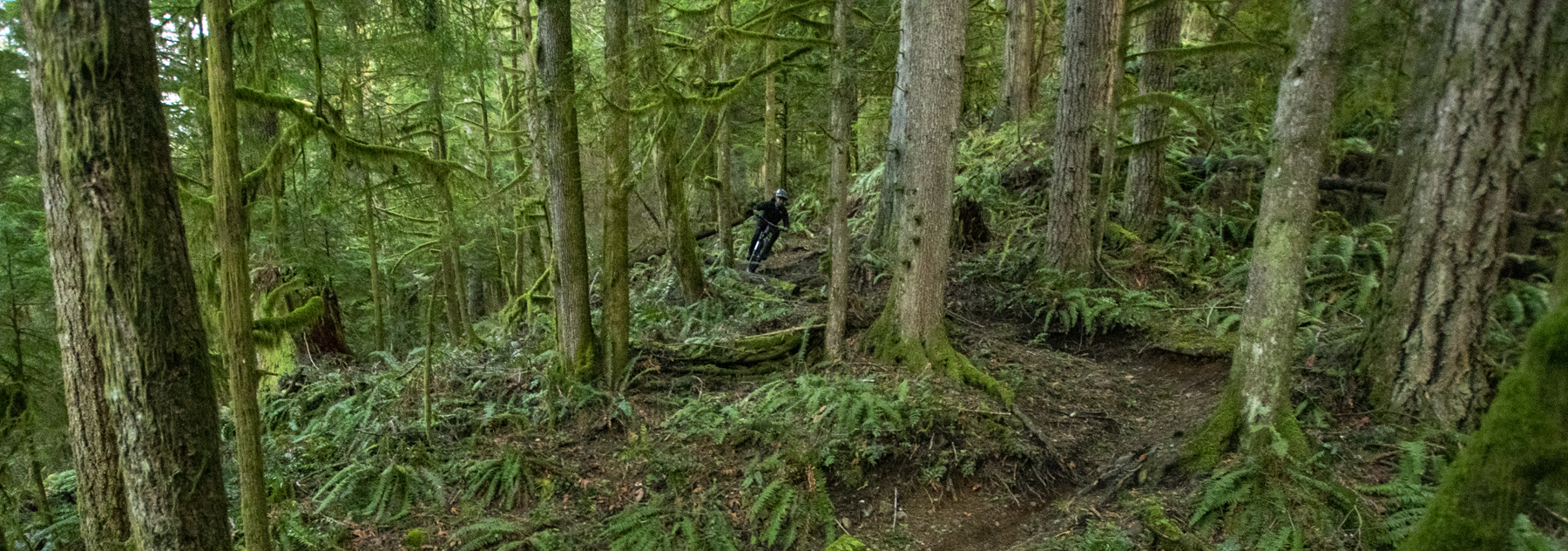
FULL REVIEW
There are a lot of aggressive shorter-travel Trail bikes on the market these days, but the original Smuggler was one of the pioneers of the genre (and we reviewed it way back in 2016). But the Smuggler disappeared from Transition’s lineup after the second-generation bike concluded its run in 2019, and only resurfaced earlier this year as a 130 mm rear / 140 mm front 29er — up by 10 mm in the rear as compared to the prior generation.
Having now spent a couple of months on the latest Smuggler, it’s a worthy successor to the super-popular prior generations — and one of the better-dialed takes on an aggressive short-travel Trail bike that we’ve been on recently, with a few small quirks.
Fit & Sizing
Transition’s recommended sizing guide puts me (6’ / 183 cm) squarely in the middle of the sizing range for the Large Smuggler, and that felt spot on — nothing about the fit of the Smuggler made me the least bit interested in deviating from the Large frame in either direction. Seeing as most of the fit numbers (617 mm effective top tube, 485 mm reach) are pretty neatly in my normal preferred range for an all-arounder Trail bike, that wasn’t a great surprise. But I think Transition has done a nice job of coming up with numbers that make for a nice, intuitive fit, and I had a very quick and easy time getting comfortable on the Large Smuggler.
If I was going to tweak anything about the fit of the Smuggler, I might be inclined to make the stack height a touch higher, but I was able to get myself into a place I was happy with by running the stock 30 mm rise bar and max spacers (though I swapped in a wider 30 mm rise bar since the stock one had previously been trimmed narrower than I prefer).
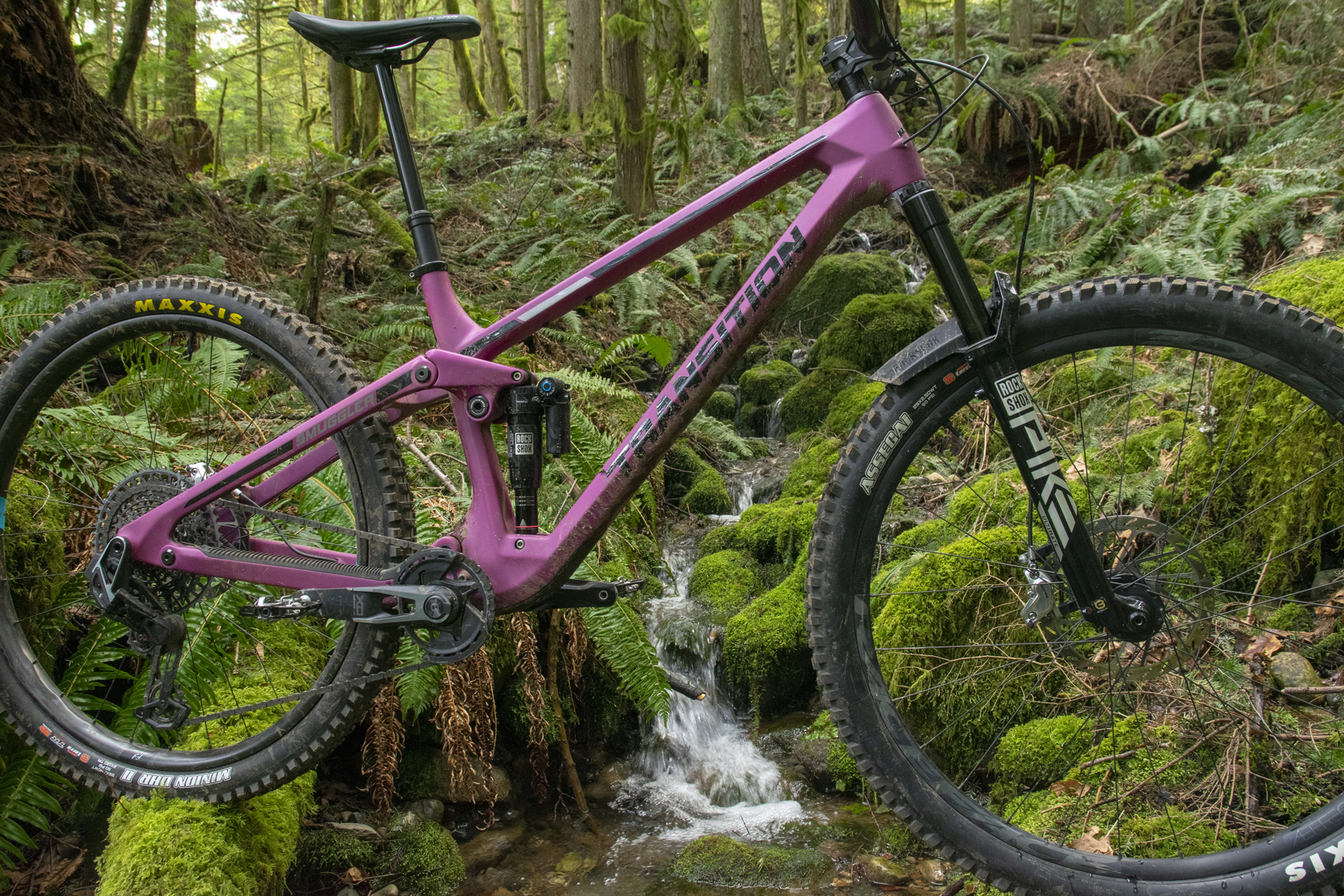
The counterargument there, of course, is that there’s a range of stuff you can do to make the cockpit on a given bike higher, but the stack height imposes a floor on how low you can go at a certain point; in any case, I was, at most, a swap of the stock bar away from being dialed, and it’s certainly not like I’d be making big changes to the Smuggler on that front if I was in charge. Folks who like notably high bars should factor that into their sizing considerations, but I don’t think it’ll cause a real issue for many people.
Climbing
The Smuggler is definitely not the absolute most efficient, XC-derived sort of ~130mm-travel bike out there, but for what it is — a more descending-oriented, aggressive take on that travel range — it pedals quite well. It’s fairly efficient first and foremost while still having respectable traction under power, and the pedaling position feels nicely sorted out for the intentions of the Smuggler — which is to say, it’s got a nicely steep seat tube angle, but one that’s dialed back just a little bit as compared to the very steepest winch-and-plummet-oriented Enduro bikes out there. The Smuggler is plenty comfortable while pedaling seated on flatter ground (where ultra-steep bikes can feel a bit cramped and awkward), while still making it easy to keep the front wheel planted without needing to focus on keeping your weight forward or anything like that. Its moderately long chainstays probably help some there too, as does the comparatively modest rear travel (which produces less dynamic sag than you get on a longer travel bike when you point it uphill and your weight shifts rearward).
The Smuggler is also a solid technical climber, but exactly how it stacks up is likely a matter of perspective. The more you’re used to bigger Enduro bikes with longer wheelbases and more ponderous handling, the more impressive the Smuggler is going to feel; if you’re coming off a more XC-oriented bike and hoping for a big step up in descending performance but modest tradeoffs in technical climbing abilities, I’d tamp down the expectations on that latter part a little bit. (The descending part, on the other hand… well, we’ll get there in a minute.)
The Smuggler does quite well if you come to it with the expectation that’s a little longer and more stable at speed than average for this class of bike, but correspondingly not quite as easy to maneuver through tight spots and loft over weird, chunky sections as some (generally shorter-wheelbase, higher-bottom-bracket) bikes. The more your technical climbs are of the rough and loose, but not super-ledgy and tight variety, the less that matters, and on smoother, more mellow climbs it’s a non-issue altogether. It’s just when you get into really tough, stair-step-y climbing with a lot of tight turns and precisely timed moves that the slightly longer wheelbase and fairly low bottom bracket (compared to some of its competitors) start to feel more noticeable on the Smuggler.
The flip side of all that is that the Smuggler feels like it’s got quite a big sweet spot in terms of the body positioning that it needs to keep both wheels planted and the rear one gripping when climbing. The more you’re finding yourself grinding up something for a long time but not doing a ton of hop moves and the like to navigate super tricky sections, the more the Smuggler’s length starts to feel like an asset. It’s still plenty quick handling for navigating most switchbacks without much fuss, pedals quite efficiently, and is generally excellent at more “brain off” grinding up climbs when the terrain permits.
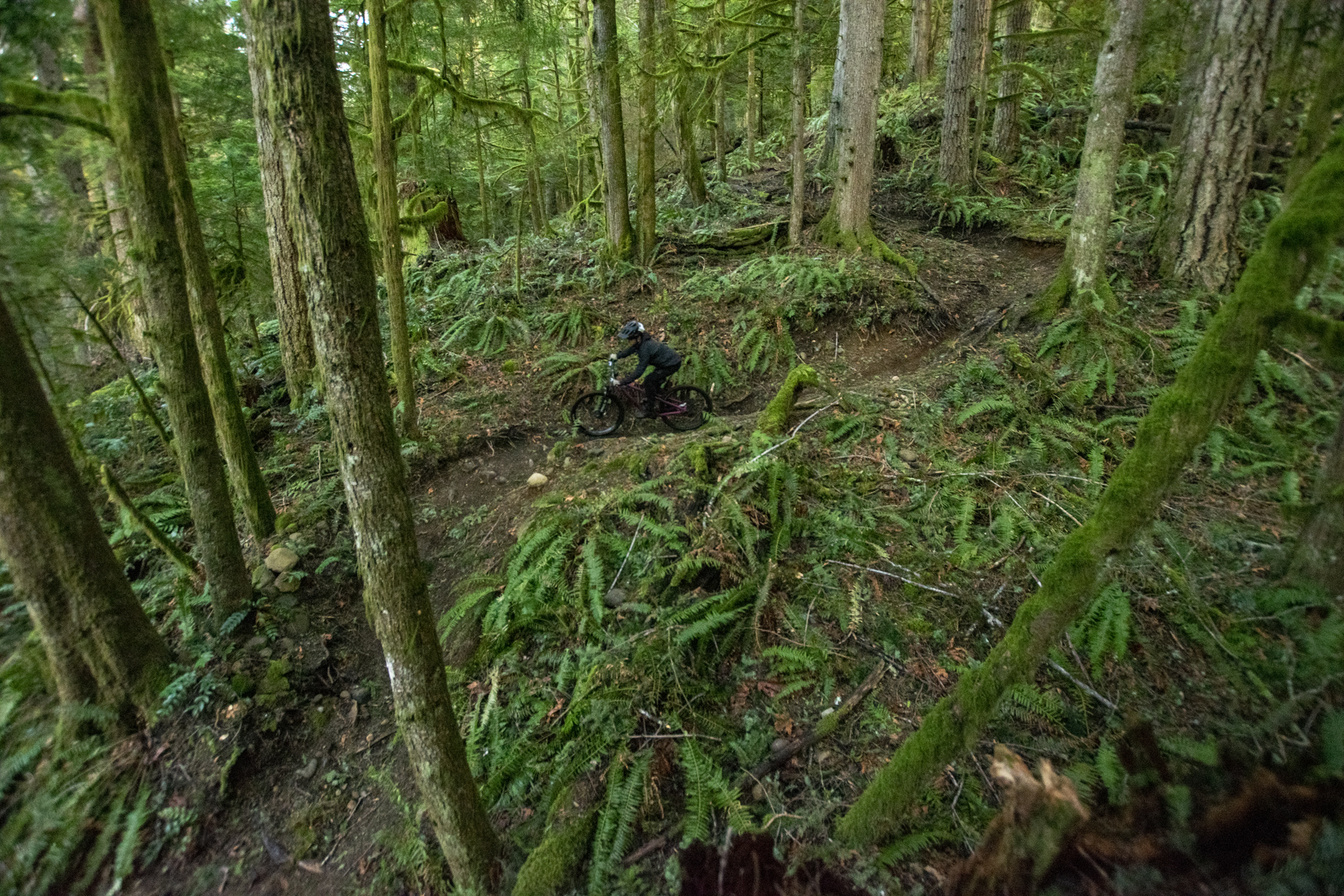
The one issue I ran into with the Smuggler’s climbing performance is that my knees rub the rocker link appreciably when pedaling. The interference isn’t so severe as to cause an interruption to my pedaling stroke or anything like that, but unless I take some care to keep my leg alignment straight, they do make perceptible contact. I don’t often have notable issues with knee rub on most bikes, and it’s not so bad on the Smuggler that it would stop me from buying one, but it’d be nice if the rocker link was pinched a bit tighter to mitigate it — there’s ample clearance between the rocker link and seat tube, though it’d take some changes to the seat stay design to have them curve in to match.
I’ve spoken to a handful of Smuggler owners and while not everyone has had similar issues, I’m not the only one, either. Folks who often have issues with knee rub should probably be wary; if you’re worried about it, a test ride to see how things go would likely be a good call.
Descending
The appeal of an aggressive-descending, shorter-travel bike as a middle ground between super burly Enduro sleds and very quick-handling, XC-focused rigs is an easy one to understand — in theory, you’re targeting a bike that’s able to handle steep, technical descents while being a lot more engaging and fun than a true big bike the rest of the time. But striking the right balance can be tricky, especially at the more aggressive, descending-focused end of the spectrum — take things too far with geometry and suspension tuning, and at some point, you end up with a short-travel Enduro bike that isn’t that much quicker handling than a proper big bike, but lacks the suspension to keep up. And while the Smuggler doesn’t magically circumvent those sorts of tradeoffs, it’s one of the best-rounded takes on the genre that we’ve ridden to date, at least for folks with the right preferences.
So who is the Smuggler for? The short version is that it’s an especially good bike for riders who want a bike that they’re still looking to descend quickly and aggressively on first and foremost, but who have some local trails that are on the smoother, less steep side of things, where a bigger Enduro bike feels overkill and ponderous. The Smuggler is happy going very, very fast a whole lot of the time, while still feeling lively and engaging on mellower, flowier trails, and can absolutely get down most steeper, more technical descents with a competent rider and a slightly dialed back approach.
As is routinely the case with bikes in this class, the Smuggler does have limits in terms of how fast it’s happy going on very steep, rough, difficult descents. It can get down most anything with a good rider and a bit of care, but the margin for error narrows considerably, as compared to bigger Enduro bikes, when speeds really start to pick up, especially when high speeds are combined with rougher, more technical trails.
The tradeoff there is that the Smuggler is a blast when you’ve got a little bit of room and pitch to open it up, but are pointed down a trail that’s not so rough as to call for a bigger, longer-travel bike. The Smuggler is lively and eager to take to the air and strikes an excellent balance between outright stability and agility. It’s quick-handling and nimble with a little bit of speed, but not to the point of feeling twitchy or overwhelmed until you really try to ride a steep, rough section at pace and are reminded that you’re only on a 130mm-travel bike, after all. There are quicker-handling options in this sort of travel range when you’re in really tight, low-speed terrain with a lot of grade reversals and the like, but with just a little bit of speed, the Smuggler becomes extremely intuitive and easy to throw around, while still being able to hold on for a long time as you keep going faster.
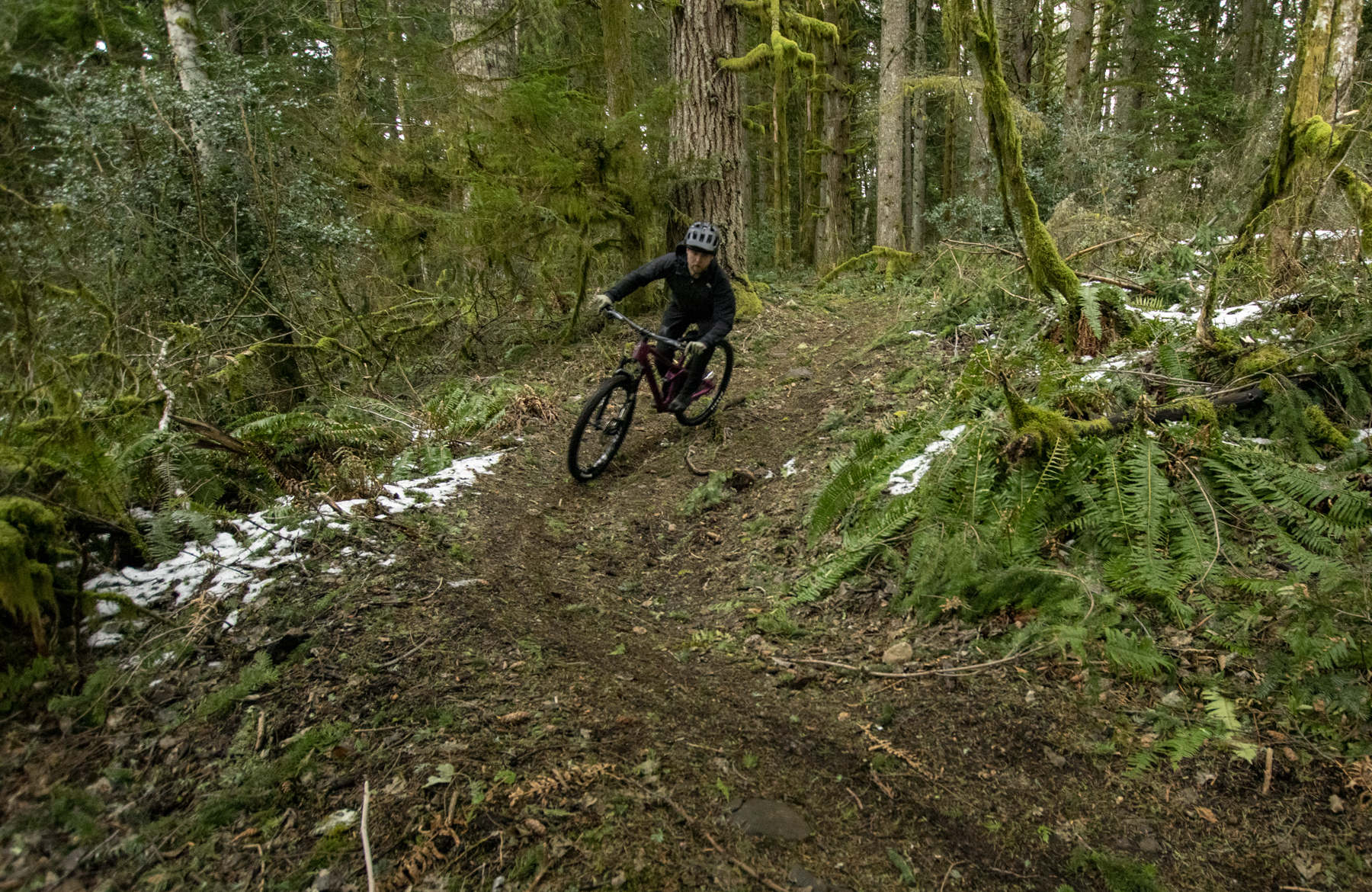
While the Smuggler doesn’t have a massive amount of suspension travel to work with, it does a very good job of making the most of what’s on tap. We’ve talked a bunch recently about the tricky balancing act that’s at play when tuning the suspension for an aggressive shorter-travel bike, and I think Transition has done quite a good job on that front. The Smuggler’s small-bump sensitivity and traction are better than average for the amount of travel on offer, but the Smuggler also manages to feel pretty supportive and composed, staying high enough in its travel to not feel like it’s just slamming into the end of stroke ramp up all the time, which can often be an issue with more cushy-feeling shorter-travel bikes. That’s not to say that the Smuggler feels like it’s got more travel than it does or anything like that — it definitely still has its limits — but the Smuggler is better sorted out than most.
Now the asterisk there is that I reviewed the Smuggler with a RockShox Super Deluxe Ultimate rear shock, and all the stock builds come with a Fox Float X in its place. And I do think that the hydraulic bottom-out circuit and the ability to firm up the high-speed compression on the Super Deluxe do help keep the Smuggler feeling supportive and composed. But that said, I’ve ridden the Float X on a lot of different bikes now, and so long as Transition got the base tune right, I think it should be a very solid fit for the bike as well. Unfortunately, that’s about all I can say on the matter, having not had the opportunity to try the stock shock on this bike.
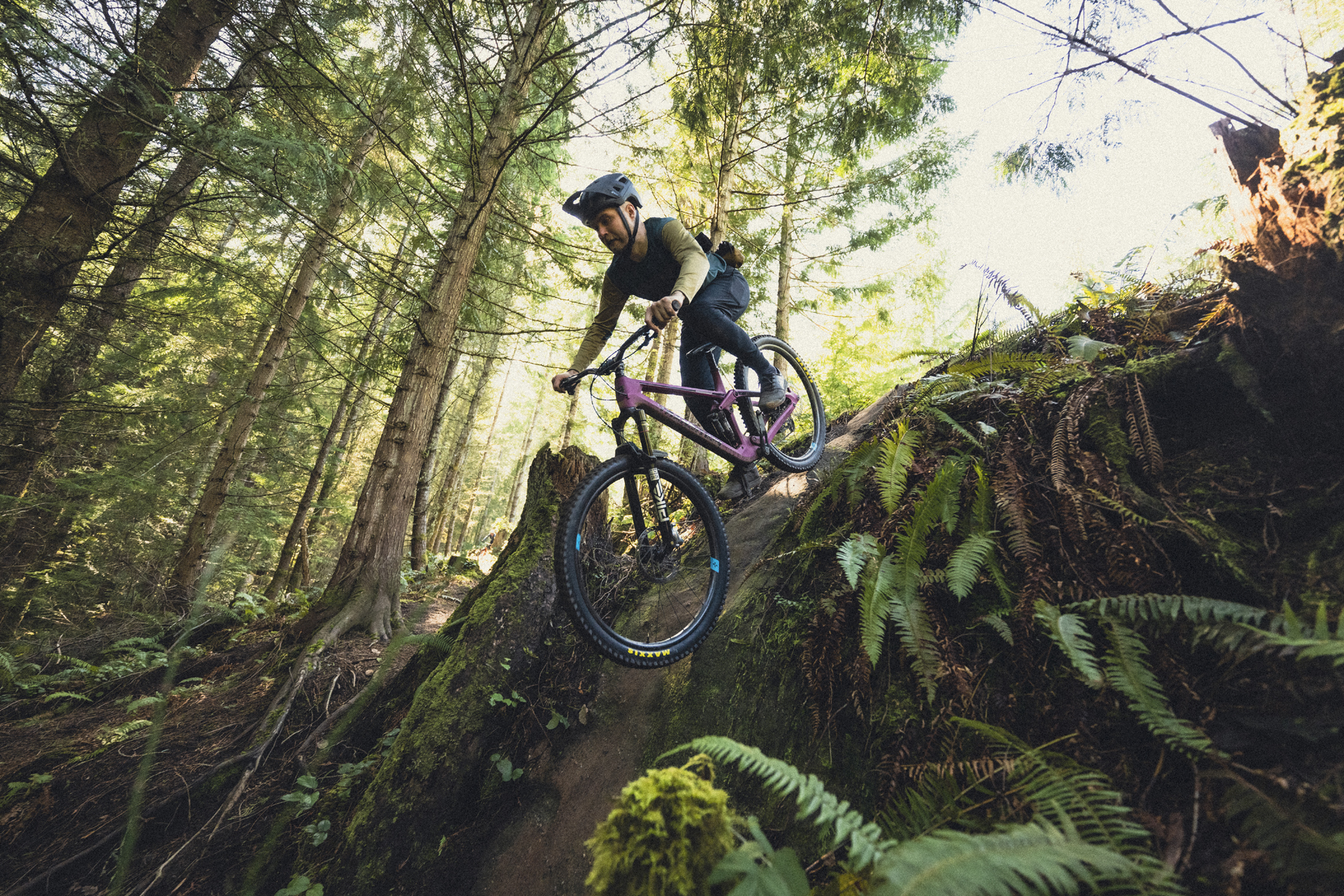
Anyway, the real point here is that I think Transition has done an especially good job of making an aggressive short-travel Trail bike that can be pushed pretty hard, but doesn’t go so far down the road of being aggressive that it just turns into an Enduro bike with worse suspension. The Smuggler wants to be pushed a bit on the descents but doesn’t need all that much pitch to come alive, is sharp handling at everything from moderate speeds on up, and still manages to be impressively stable and confidence-inspiring up to the point where its modest suspension travel becomes the limiting factor.
The Build
I tested the Smuggler with a decidedly non-standard build that served as my initial test platform for the new SRAM Transmission, and with that came a RockShox Pike Ultimate / SuperDeluxe Ultimate suspension package in lieu of the Fox 34 / Float X combo that Transition opted for. In short, my test bike started life as a pre-production build that was a mix of the stock GX and GX AXS builds, but had the aforementioned suspension swap, a SRAM X0 Transmission groupset, and Code Ultimate Stealth brakes.
Transition now offers an X0 T-Type (aka, Transmission) build on the Smuggler, but it still comes with Fox suspension (34 Grip2 / Float X Factory) in place of the RockShox pieces on my test bike. Fortunately, I’ve got plenty of time on both the 34 and Float X, and they’re broadly comparable to the Pike / Super Deluxe combo (in terms of intended use and the rest; there are definitely performance differences), and a good match for the Smuggler in general.
Anyway, I like what Transition has done with the builds on the Smuggler. SRAM Code brakes with a 200 mm front rotor are standard on all builds, as are appropriately long-travel OneUp dropper posts, and so on. It’s all well thought out and strikes a nice middle ground for the intended use of the Smuggler, putting slightly beefier parts (e.g. the brakes) where they’re most needed and saving a little weight where reasonable.
Comparisons
Guerrilla Gravity Trail Pistol
The Trail Pistol is the best comparison here, especially once it’s had the travel bumped up to 130 mm rear / 140 mm front (which Guerrilla Gravity condones, and wound up being my preferred setup on the bike), but there are still some differences between the two. The Smuggler is a touch more stable at speed and has a slightly bigger sweet spot in terms of its preferred body positioning, particularly toward the more centered / upright end of the range. The Trail Pistol is by no means super demanding of being ridden from a forward body position with a lot of weight on the front wheel, but it shades that direction a little bit more than the Smuggler. On the flip side, the Trail Pistol is a little quicker handling at lower speeds and a little easier to manage as a technical climber. Pedaling efficiency between the two is close, but the Smuggler probably has a slight edge.
The Spectral 125 is the next closest comparison here, but the differences start to get more pronounced. The Spectral 125 is a notch more stable at speed than the Smuggler, but is slower handling at lower speeds and in tighter spots, and is more demanding of being ridden from a forward, aggressive stance than the Smuggler (or the Trail Pistol for that matter).
The suspension performance between the two bikes is a big part of the story as well. The Smuggler’s suspension feels more supportive and does a better job of riding higher in its travel than the Spectral 125, which pays particular dividends on this sort of aggressive shorter-travel bike with limited total travel to work with. The Spectral 125 is more plush on smaller bumps but gives up some support on higher-speed chop, which results in it relying on the end-of-stroke ramp up more and, at times, feeling harsher because it’s leaving itself with less total travel to work with in those scenarios. The Smuggler also pedals a little more efficiently.
The Tallboy and the Smuggler are in some ways two sides of the same coin. They’re both bikes that are very good at going fast on smoother, flowier trails while having enough technical chops to get down some steeper, rougher stuff. But the Tallboy is more efficient under power, less stable and composed at speed, and generally feels like a more XC-derived, quicker-handling take on the same sort of bike.
The more you care about technical climbing ability, find yourself doing a lot of rolling terrain with quick ups and downs, and/or want something that feels a little more like a beefed-up XC bike than a scaled-down Enduro one, the more sense the Tallboy makes. Conversely, the Smuggler feels a bit more specifically descending-oriented and has a higher top end if you’re inclined to push the limits on the sorts of trails you choose to point it down. Both have notably excellent suspension performance for their overall amount of travel, but the Smuggler (1) has more and (2) is more stable and confidence-inspiring at speed, at the expense of some low-speed handling sharpness.
The Element is much more similar to the Tallboy than it is to the Smuggler. Our full review of the Tallboy (linked above) goes into more detail about how those two bikes compare — suspension performance being the primary differentiator — but pretty much everything else I said about how the Tallboy compares to the Smuggler also applies to the Element.
We’ve had different reviewers on the Phantom and the Smuggler, so, unfortunately, can’t directly compare the two, but from talking to our folks who’ve spent time on the Phantom, it seems like an interesting comparison. My hunch is that the Phantom sort of splits the difference between the Tallboy and the Smuggler in terms of where they sit on the continuum between being a little more XC-derived and efficient (Tallboy) vs. burlier and more stable (Smuggler). The Phantom also favors a more neutral, centered stance, and while the Smuggler accommodates one pretty well, I suspect that it’s less specifically oriented in that direction than the Phantom.
This is an interesting comparison. In terms of fit, handling, and body positioning the two actually remind me of each other a good bit (especially with the Fuel EX in the low flip chip / neutral headset position, which makes their geometry most similar — the Fuel EX has a lot of adjustability, and we’ll comment more on that in the full review, coming very soon).
Where they differ more is in terms of suspension performance. The Fuel EX has 10 mm more at each end, and in addition to feeling like it’s just got more travel, it feels substantially more plush and cushy in its performance, as compared to the more supportive, more lively Smuggler. Pedaling efficiency is surprisingly close given those differences, but the Fuel EX is quite a bit more compliant and forgiving at lower speeds and feels somewhat lightly damped and less supportive when you start going faster and hitting stuff harder. I think the shock tune on the Fuel EX is a significant part of the reason why — and again, we’ll go deeper in the full review that’s coming quite soon — but their differences in suspension performance make the two bikes feel substantially different.
We’re still spending a lot of time on the new SB135, and our full review is a ways out, but it’s a very different take on this sort of bike. The SB135 is more nimble, easier to throw around in the air, and generally slash, make shapes, and otherwise ride with a playful style, especially on smoother, flowier trails with lots of stuff to get airborne from. The Smuggler does that stuff pretty well too, but it’s more stable at speed and feels more interested in going fast at the expense of a solid chunk of the SB135’s ultra-playful character.
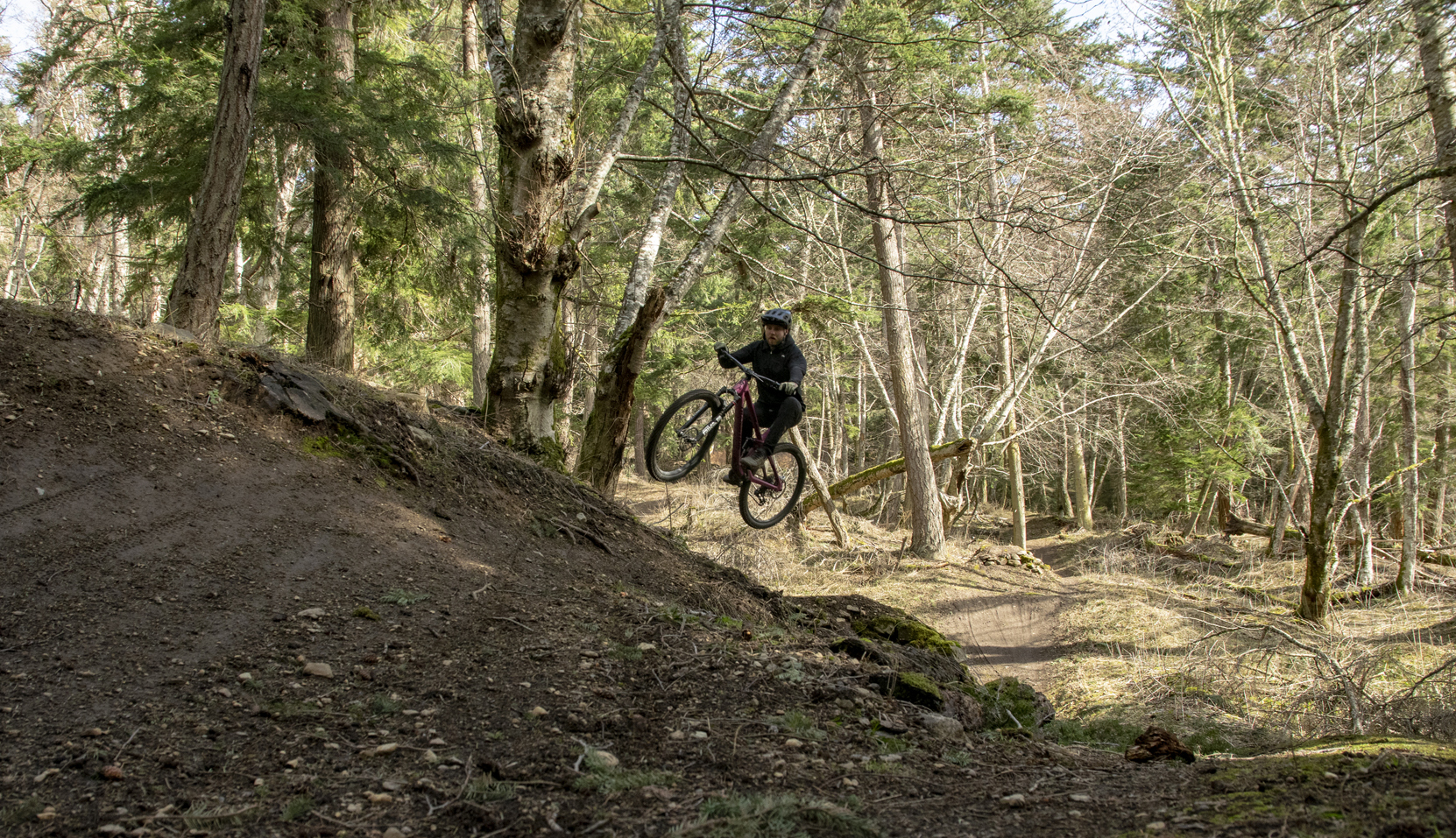
Who’s It For?
The Transition Smuggler is a bike for riders who prioritize descending performance but want a bike that’s quicker handling, more lively, and more engaging on trails that aren’t consistently ultra steep and rough than a bigger Enduro bike. It pedals well, is lively and eager to get airborne, and strikes an excellent balance between stability at speed and nimbleness in tighter spots, particularly for faster, more aggressive riders who’d favor a touch more of the former than the latter.
Bottom Line
Longtime fans of the Smuggler have had to wait patiently for the new one to pop up, but with the latest version, Transition has put together an excellent take on an aggressive-descending short(ish)-travel Trail bike. The Smuggler is versatile (albeit with some more focus on descending at speed over technical climbing prowess), super fun on fast, flowy trails, and can absolutely handle some steep, rough, technical ones if you dial back the speed a little bit and ride cleanly — and for all those reasons, it’s probably my personal favorite bike in this class. Just check your calf / knee clearance relative to the rocker link, since mine (and others’) rub a bit.


Great article! Interesting comparison bikes. I would have thought it competes with more 150/140 bikes. How do you think this bike would ride with 150/140 by removing the spacer and up-forking 10mm? I’m looking to replace a Yeti 5.5 with another aggressive trail bike but still want it to be light and capable. Love my Transition Spur but this review makes me think the Smuggler is more of a “Super Spur” rather than a Sentinel “light”.
One of the best comparisons i think would be the pivot trail 429. Feels like a big bike but is weighing 27-29ish lbs. That is a ripper and honestly much more bang for buck when you look at transitions smugglers builds.
I tend to think the 429 is closer to something like the Spur but really Pivot and Transition couldn’t be further apart in design philosophy. Pivot has stuck with fairly conservative short geometry and transition has gone long and slack. A big part of that is probably where each is headquartered. Pivot in techy desert terrain with lots of xc, Transition in steep and jumpy pnw terrain.
Any thoughts as compared to the Revel Rascal?
Great review. Thank you for doing it.
Would love to see a Smuggler 130/ 140 vs. Smuggler 140/ 150 comparison.